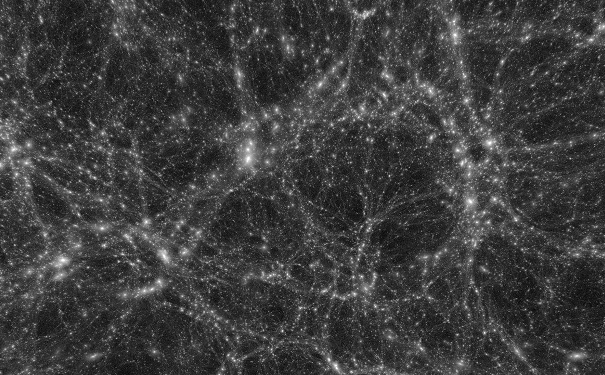
A Dwarf Galaxy forming (the stars are in yellow, the gas is in cyan and Dark Matter is in red) at about half the current age of the Universe. Image Credit: Bourke, Crain and Duffy.

A dark matter-only simulation, showing the dark matter stretching across millions of light years of the Universe. Image Credit: Bourke and Duffy.
The dynamics of dark matter are more complicated on a single galaxy level.
Researchers from the International Centre for Radio Astronomy Research (ICRAR) have discovered that the recently discovered correlation between the concentration and mass of dark matter breaks down around single galaxies. The gravitational field of a single galaxy is dominated by the stars and gas, so the dark matter is forced to modify its motion.
In galaxy clusters, however, the gas is so hot it is unable to accumulate locally and become the dominant gravitational component. “When the gas is smoothly distributed the dynamics of even complex galaxy clusters with thousands of individual galaxies become quite simple, and this is why simple correlations between the concentration and mass of the system become easy to explain,” said ICRAR researcher Alan Duffy.
“If we zoom in to the case of a single galaxy, the gas is able to cool and cluster to smaller scales, eventually forming stars, and (the) gravity of these components dominate over the dark matter.”
To measure the properties of dark matter, the researchers have run one of the highest resolution simulations in the world on the new Pawsey Supercomputer in Western Australia. The new simulation, of a single Milky Way-like galaxy, will enable researchers to determine when the galaxies will deviate from the concentration-mass relation.
The simulation suggests that dark matter still dominates in clusters of galaxies, forming the previously found relation between concentration and mass in the biggest clusters. “This seems to be the case, but only if supermassive black holes are included; these keep the gas in the cluster hot and stop the formation of too many stars,” Dr Duffy said.
The prototype of the Square Kilometre Array– the Australian Square Kilometre Array Pathfinder (ASKAP)- will play an important role in determining how dark matter behaves on small (hundreds or thousands of light years) scales. “ASKAP can make very precise measurements of the rotation speeds of galaxies, as well as detect incredibly faint tiny satellites galaxies, all of which are crucial probes of the nature of dark matter.”
This will indicate the dark matter temperature (the speed of the particles that comprise it). “If the dark matter is ‘cold’ then the individual particles are travelling slowly; if the dark matter is ‘warm’ the particles are termed relativistic, and are travelling anywhere up to 95 per cent of the speed of light. Or perhaps it’s a mix… ‘lukewarm’ maybe.”
The hotter the dark matter, the harder it is for the gravity of a collapsing galaxy to hold onto the dark matter before it flies off. “This means that hot dark matter universes would contain fewer satellite galaxies, and less concentrated larger galaxies,” Dr Duffy said.
“But to accurately predict these properties to test with ASKAP we need the new simulations that the Pawsey Supercomputer is powerful enough to run.”






